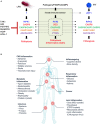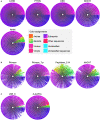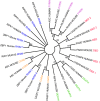The PANoptosome: A Deadly Protein Complex Driving Pyroptosis, Apoptosis, and Necroptosis (PANoptosis)
- PMID: 32582562
- PMCID: PMC7283380
- DOI: 10.3389/fcimb.2020.00238
The PANoptosome: A Deadly Protein Complex Driving Pyroptosis, Apoptosis, and Necroptosis (PANoptosis)
Abstract
Programmed cell death is regulated by evolutionarily conserved pathways that play critical roles in development and the immune response. A newly recognized pathway for proinflammatory programmed cell death called PANoptosis is controlled by a recently identified cytoplasmic multimeric protein complex named the PANoptosome. The PANoptosome can engage, in parallel, three key modes of programmed cell death-pyroptosis, apoptosis, and necroptosis. The PANoptosome components have been implicated in a wide array of human diseases including autoinflammatory diseases, neurodegenerative diseases, cancer, microbial infections, and metabolic diseases. Here, we review putative components of the PANoptosome and present a phylogenetic analysis of their molecular domains and interaction motifs that support complex assembly. We also discuss genetic data that suggest PANoptosis is coordinated by scaffolding and catalytic functions of the complex components and propose mechanistic models for PANoptosome assembly. Overall, this review presents potential mechanisms governing PANoptosis based on evolutionary analysis of the PANoptosome components.
Keywords: ASC; PANoptosis; PANoptosome; RIPK1; RIPK3; ZBP1; caspase-1; caspase-8.
Copyright © 2020 Samir, Malireddi and Kanneganti.
Figures



Similar articles
-
Identification of the PANoptosome: A Molecular Platform Triggering Pyroptosis, Apoptosis, and Necroptosis (PANoptosis).Front Cell Infect Microbiol. 2020 May 29;10:237. doi: 10.3389/fcimb.2020.00237. eCollection 2020. Front Cell Infect Microbiol. 2020. PMID: 32547960 Free PMC article.
-
From pyroptosis, apoptosis and necroptosis to PANoptosis: A mechanistic compendium of programmed cell death pathways.Comput Struct Biotechnol J. 2021 Aug 3;19:4641-4657. doi: 10.1016/j.csbj.2021.07.038. eCollection 2021. Comput Struct Biotechnol J. 2021. PMID: 34504660 Free PMC article. Review.
-
The regulation of the ZBP1-NLRP3 inflammasome and its implications in pyroptosis, apoptosis, and necroptosis (PANoptosis).Immunol Rev. 2020 Sep;297(1):26-38. doi: 10.1111/imr.12909. Epub 2020 Jul 29. Immunol Rev. 2020. PMID: 32729116 Free PMC article. Review.
-
PANoptosis: Emerging mechanisms and disease implications.Life Sci. 2023 Nov 15;333:122158. doi: 10.1016/j.lfs.2023.122158. Epub 2023 Oct 6. Life Sci. 2023. PMID: 37806654 Review.
-
It's All in the PAN: Crosstalk, Plasticity, Redundancies, Switches, and Interconnectedness Encompassed by PANoptosis Underlying the Totality of Cell Death-Associated Biological Effects.Cells. 2022 Apr 29;11(9):1495. doi: 10.3390/cells11091495. Cells. 2022. PMID: 35563804 Free PMC article. Review.
Cited by
-
Identification of a PANoptosis-related prognostic model in triple-negative breast cancer, from risk assessment, immunotherapy, to personalized treatment.Heliyon. 2024 Sep 30;10(19):e38732. doi: 10.1016/j.heliyon.2024.e38732. eCollection 2024 Oct 15. Heliyon. 2024. PMID: 39430460 Free PMC article.
-
Biological function and potential application of PANoptosis-related genes in colorectal carcinogenesis.Sci Rep. 2024 Sep 5;14(1):20672. doi: 10.1038/s41598-024-71625-7. Sci Rep. 2024. PMID: 39237645 Free PMC article.
-
Pancancer analysis reveals the role of disulfidptosis in predicting prognosis, immune infiltration and immunotherapy response in tumors.Medicine (Baltimore). 2023 Dec 29;102(52):e36830. doi: 10.1097/MD.0000000000036830. Medicine (Baltimore). 2023. PMID: 38206694 Free PMC article.
-
FUNDC1 protects against doxorubicin-induced cardiomyocyte PANoptosis through stabilizing mtDNA via interaction with TUFM.Cell Death Dis. 2022 Dec 5;13(12):1020. doi: 10.1038/s41419-022-05460-x. Cell Death Dis. 2022. PMID: 36470869 Free PMC article.
-
PANoptosis-like death in acute-on-chronic liver failure injury.Sci Rep. 2024 Jan 3;14(1):392. doi: 10.1038/s41598-023-50720-1. Sci Rep. 2024. PMID: 38172209 Free PMC article.
References
-
- Aganna E., Martinon F., Hawkins P. N., Ross J. B., Swan D. C., Booth D. R., et al. . (2002). Association of mutations in the NALP3/CIAS1/PYPAF1 gene with a broad phenotype including recurrent fever, cold sensitivity, sensorineural deafness, and AA amyloidosis. Arthritis Rheum. 46, 2445–2452. 10.1002/art.10509 - DOI - PubMed
-
- Aksentijevich I., Nowak M., Mallah M., Chae J. J., Watford W. T., Hofmann S. R., et al. . (2002). De novo CIAS1 mutations, cytokine activation, and evidence for genetic heterogeneity in patients with neonatal-onset multisystem inflammatory disease (NOMID): a new member of the expanding family of pyrin-associated autoinflammatory diseases. Arthritis Rheum. 46, 3340–3348. 10.1002/art.10688 - DOI - PMC - PubMed
Publication types
MeSH terms
Grants and funding
LinkOut - more resources
Full Text Sources
Miscellaneous

